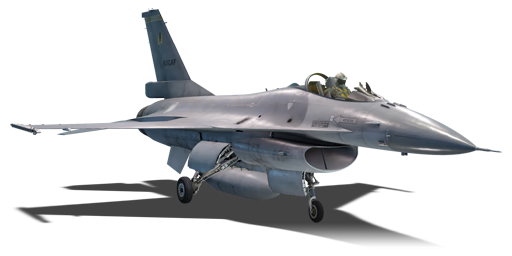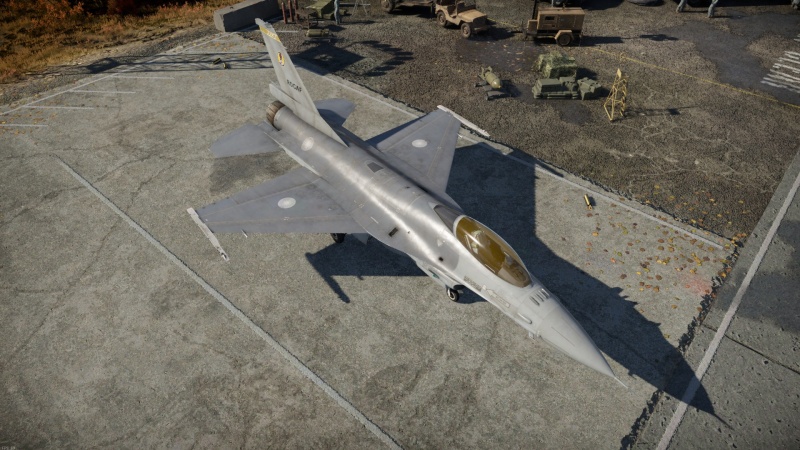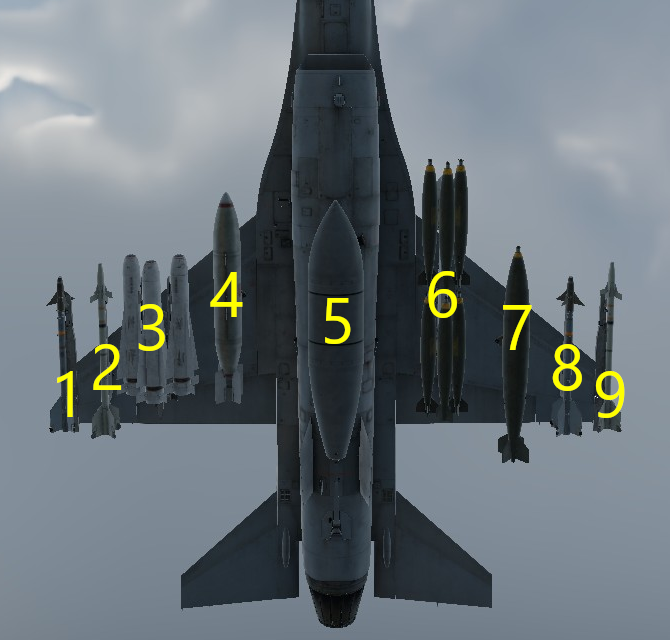Difference between revisions of "F-16A MLU (China)"
(→Suspended armament: Updated) |
Colok76286 (talk | contribs) (→Armaments: Added Ballistic Computer template) |
||
| Line 122: | Line 122: | ||
{| class="wikitable" style="text-align:center" | {| class="wikitable" style="text-align:center" | ||
|- | |- | ||
| − | ! colspan=" | + | ! colspan="5" | [[Ballistic Computer]] |
|- | |- | ||
| − | ! CCIP (Guns) !! CCIP (Rockets) !! CCIP (Bombs) !! CCRP (Bombs) | + | ! CCIP (Guns) !! CCIP (Rockets) !! CCIP (Bombs) !! CCRP (Bombs) !! Lead indicator |
|- | |- | ||
| − | | {{Tick}} || {{Tick}} || {{Tick}} || {{Tick}} | + | | {{Tick}} || {{Tick}} || {{Tick}} || {{Tick}} || {{Tick}} |
|- | |- | ||
|} | |} | ||
Revision as of 04:57, 20 June 2023
| This page is about the jet fighter F-16A MLU (China). For other versions, see F-16 (Family). |
Contents
Description
The ␗F-16A Block 20 MLU Fighting Falcon, also known as the F-16 Block 20, was the cornerstone of the ROCAF before they were upgraded in the 2020s. The introduction of the F-16 to the ROCAF can be traced back to the late 1990s. After Dassault sold a wing of Mirage 2000-5Ei to the ROCAF to counter the menacing PLAAF with more advanced fighter jets, the US also agreed to supply some F-16s. These jets were approved while the F-16C was the standard variant of the F-16 family so, having to comply with the treaties between Mainland China and US regarding not providing US-equivalent equipment, F-16A/B Block 20s were delivered. As one of the most advanced jets of the era, F-16 Block 20s served as the cornerstone of ROCAF, both in their initial form and after being upgraded to the latest F-16V standards against the ongoing PLAAF patrols.
Introduced in Update "Apex Predators", the F-16A MLU is a hybrid version between the F-16A Block 15 MLU and the airframe of the F-16C exclusively for the ROCAF; this F-16 provides a long-awaited, reliable multirole fighter featuring a pulse-Doppler AN/APG-66 radar as well as sporting some of the latest AAMs in-game. For players who need both interception and ground-attacking capabilities, the Mavericks and LDGP bombs onboard will also make light work of any ground targets.
General info
Flight performance
Instead of Block 10 or Block 15 ADF, in ROCAF's case, their F-16A MLU (Block 20) has major differences in terms of thrust and appearance: to tell a Block 20 and others apart, there are two parts to differentiate- IFF antenna and the tail; while Block 10 has no antenna and ADF has the "bird-slicer" antenna, MLU received AN/APX-113 IFF with a rounded antenna. The tail in this case also received a drogue chute for highway strip operations. Other than that, the MLU performs mostly identically to its counterparts with slightly less military thrust. The F-16s are known to be one of the most manoeuvrable jets with their impressive engine thrust and design features for dogfights. In most cases, jets that are an era behind the F-16 will very likely having a hard time biting onto the tail of F-16, since their relatively light weight does help in dogfights and acceleration. The F-16 is also the first mass-produced fighter to use FBW (Fly-by-wire) and in this case, instead of the physical limits of the airframe itself, it also has software limits at 9G continuous overload, so players will have to take extra caution on the speed of the jet: any high speed turns over 750 km/h will very likely trigger this limits.
| Characteristics | Max speed (km/h at 10,973 m) |
Max altitude (metres) |
Turn time (seconds) |
Rate of climb (metres/second) |
Take-off run (metres) | |||
|---|---|---|---|---|---|---|---|---|
| AB | RB | AB | RB | AB | RB | |||
| Stock | 2,093 | 2,063 | 15240 | 20.3 | 20.6 | 252.7 | 240.3 | 850 |
| Upgraded | 2,198 | 2,146 | 19.3 | 19.8 | 340.7 | 295.0 | ||
Details
| Features | |||||
|---|---|---|---|---|---|
| Combat flaps | Take-off flaps | Landing flaps | Air brakes | Arrestor gear | Drogue chute |
| X | ✓ | ✓ | ✓ | ✓ | ✓ |
| Limits | ||||||
|---|---|---|---|---|---|---|
| Wings (km/h) | Gear (km/h) | Flaps (km/h) | Max Static G | |||
| Combat | Take-off | Landing | + | - | ||
| 1,555 | 482 | N/A | 470 | 463 | ~__ | ~__ |
| Optimal velocities (km/h) | |||
|---|---|---|---|
| Ailerons | Rudder | Elevators | Radiator |
| < ___ | < ___ | < ___ | N/A |
Engine performance
| Engine | Aircraft mass | |||||
|---|---|---|---|---|---|---|
| Engine name | Number | Basic mass | Wing loading (full fuel) | |||
| Pratt & Whitney F100-PW-220 | 1 | 7,990 kg | ___ kg/m2 | |||
| Engine characteristics | Mass with fuel (no weapons load) | Max Gross Weight | ||||
| Weight (each) | Type | 8m fuel | 20m fuel | 29m fuel | ||
| 1,470 kg | Afterburning low-bypass turbofan | 8,962 kg | 10,213 kg | 11,230 kg | 16,048 kg | |
| Maximum engine thrust @ 0 m (RB/SB) | Thrust to weight ratio @ 0 m (WEP) | |||||
| Condition | 100% | WEP | 8m fuel | 20m fuel | 29m fuel | MGW |
| Stationary | 6,490 kgf | 8,985 kgf | 1.00 | 0.88 | 0.80 | 0.56 |
| Optimal | 7,434 kgf (1,555 km/h) |
15,225 kgf (1,400 km/h) |
1.70 | 1.49 | 1.36 | 0.95 |
Survivability and armour
Other than the airframe and alloy skins, the F-16 MLU has no extra protection for pilot or critical equipment. While the jet has equipment like self-sealing fuel tanks and EFS for the engine, if the engine does suffer from a fire, due to only having a single engine, it will still have lesser chance to make it back to the airfield.
Modifications and economy
Armaments
| Ballistic Computer | ||||
|---|---|---|---|---|
| CCIP (Guns) | CCIP (Rockets) | CCIP (Bombs) | CCRP (Bombs) | Lead indicator |
| |
|
|
|
|
Offensive armament
The F-16A MLU (China) is armed with:
- A choice between two presets:
- 1 x 20 mm M61A1 cannon, wing root-mounted (512 rpg)
- 1 x 20 mm M61A1 cannon + 90 x countermeasures
Suspended armament
The F-16A MLU (China) can be outfitted with the following ordnance:
| 1 | 2 | 3 | 4 | 5 | 6 | 7 | 8 | 9 | ||
|---|---|---|---|---|---|---|---|---|---|---|
| 500 lb LDGP Mk 82 bombs | 3 | 3 | 3 | 3 | ||||||
| 500 lb Mk 82 Snakeye bombs | 3 | 3 | 3 | 3 | ||||||
| 2,000 lb LDGP Mk 84 bombs | 1 | 1 | 1 | 1 | ||||||
| AGM-65B missiles | 1, 3 | 1, 3 | ||||||||
| AIM-7M Sparrow missiles | 1 | 1 | ||||||||
| AIM-9L Sidewinder missiles | 1 | 1 | 1 | 1 | 1 | 1 | ||||
| AIM-9P Sidewinder missiles | 1 | 1 | 1 | 1 | 1 | 1 | ||||
| 300 gal drop tanks | 1 |
| Default weapon presets | |
|---|---|
| |
Usage in battles
Thanks to its late introduction in 1998, the F-16A MLU has the strengths from both the baseline A series and ADF, where players could utilize the jet both for intensive air-defense operations and makeshift ground attacker.
Air: The Falcon
For players who were frustrated from the inferior radar performance of J-8B or J-7E, the F-16A MLU brings new AN/APG-66 radar to the table. This also marks the introduction of the long awaited PD-capable radar and all-aspect IR AAMs for the Chinese tech tree. The later blocks of F-16A were upgraded with access with radar-guided missiles while the baseline models already has at most 6 IR AAMs for disposal; in terms of air-to-air operations, the jet itself performs exactly like ADFs with very similar engine thrust (albeit slightly lower in military thrust). But one major factor for the overall capability of F-16 is the limited FBW overload at only 9G, most jets in game can pull up to 13G at extreme occasions for snap-shots to enemy jets; MLU has to beware of such overload limits especially at high speeds, the jet itself is known for its excellent manoeuvrability at lower airspeed, most jets at its tier especially heavier jets such as F-14A and MiG-23MLD will have some hard time handling F-16A. In terms of AAMs, as mentioned there are at most 6 of them in either full-IR AAM or 4 IR AAMs+ 2 SARH AAMs loadouts. If players want to gain situational awareness to enemy jets, the AN/APG-66 won't disappoint players with its long detection range and being a pulse-Doppler radar, jets even at lower altitude will be visible to the radar. Make sure to check the radar and RWR in regular basis for best efficiency, bringing AIM-7M for high-altitude targets at front aspect is always a good option for extra XP or at least forcing these targets to lower altitude; while full IR AAM loadout can make sure MLU has the chance to take down careless targets given the missile tracks onto the jet itself instead of their flares (both AIM-9P and 9L are susceptible to flares).
While bringing some bombs for extra XP and credit is viable, only make sure to use them when the skies is mostly cleared out; if any enemies come into play, it's better jettison the bomb pylons for good, more bombs or payloads means lesser chance to win a dogfight.
Ground: Jack-of-all-trades
The introduction of the F-16A MLU means the Chinese tech tree finally has the upper-hand in terms of being a support fighter. While the F-16A has no radar-guided missiles at all and the F-16A ADF trades all its ground-attacking ordnance for better interception capability, the MLU has access to both types of weapons. If players found previous top-tier jets of PLAAF/ROCAF are less capable for either interception or ground attack missions, or if the SPAAs are less than desirable, this will be a great alternative to all these aforementioned flawed vehicles; while there are up to 12 bombs at disposal, for overall safety of the jet itself, options for 6 AGM-65Bs are also available as well where these missiles are still effective on taking out ground vehicles via its TV search camera. Using the custom loadouts can also means it can takes six 500 lbs, six AGM-65Bs for ground-attacking while leaving the 2 pairs of outer-board pylons for IR AAMs; after taking out high-value ground targets from altitude using the aforementioned air-to-ground ordnance, this leaves its capability to also send enemy attackers or rotorcraft straight back to their hanger, 4 x AIM-9L also can make sure careless attackers will have lesser chance to evade the missiles when they are too concentrated on ground-attacking, while the AIM-7M can be used to take out high-altitude targets or force them to quit attacking for their own survival. Do also beware either missiles SPAAs or enemy missiles from aircraft though, leave the battlefield if the tides have turned to get the best of the jet.
Pros and cons
Pros:
- Equipped with both SARH missiles and air-to-ground weapons, unlike most counterparts in different nations
- Radar has TWS unlike other F-16 variants
- Impressive payload for interception missions with up to 6 x AAMs
- Impressive manoeuvrability at around 700 km/h, useful when there's the need for a dogfight
- Equipped with a drogue chute for shorter landing distance
Cons:
- Suffers from the FBW overload limits of 9G
- Rather small 20 mm ammunition count
- Engine consumes jet fuels at high rate when afterburning, will run out of fuel relatively quickly without drop tanks
- Lacks IRST sensor for target acquisition
- Not equipped with guided bombs for safer ground attacking approach
History
In the 1980s, plans were made for the ROCAF to buy F-16/79s (equipped with J79 engine and worse radar than the F-16A) and F-20 Tigersharks, but failed due to the improving Sino-US relationship as well as limitations of the 1979 Communique. In the 1990s, after the PLAAF purchased numbers of Su-27SK Flanker-B and the increase in new domestic PLAAF jets, ROCAF considered the expansion of the PLAAF to be a major threat as the ROCAF fleet still consisted of masses of obsolete F-104 and F-5E, as well as very few F-CK-1 Indigenous Defense Fighter (IDF; aka Ching-Kuo 經國號) and Mirage 2000-5E/F series. In 1989, after the sale of Mirage 2000s to ROCAF, George HW Bush, who was at the time going for presidency, agreed to the sale of 150 F-16A/B alongside weaponry and maintenance equipment to the ROCAF during his election campaign and the sale was dubbed "Peace Pheasant" (和平鳳凰).
By the time this sale was approved, General Dynamics had already started the production run for the new F-16C/D series. To reduce the overhead for reopening production lines of previous models, ROCAF and GD agreed on a hybrid version - the Block 20 with F-16 Mid-Life Upgrade (MLU) electronics, F100-PW-220 engine, and airframe and parts of both A and C variants to be delivered to the ROCAF. The new jet rolled off the line in July 1996, which happened to be the heat of 2nd Taiwan Strait Crisis and they were delivered to ROCAF a year later to the 455th FW at Chiayi Airbase (嘉義水上基地), then 401st FW at Hualien Airbase (花蓮基地) in 2002 for a total of 150 jets delivered (120 F-16A and 30 F-16B variants). The new jets solved the major problem of the replacement of F-104 series and strengthened ROCAF's self-defense capability. While the BVR capability was hindered by the AIM-7M Sparrows delivered alongside with the jet, during the first decade of 21st Century, the US also approved the sales of AIM-120C-5/7, AGM-65G Mavericks, and AGM-84L Harpoons for delivery in 2002 and 2007.
While the combat capability of the new 4th generation jets surpassed PLAAF in early 2000s, as the estimate of the number of 4th gens in the PLAAF had increased significantly by late 2010s, ROCAF also agreed on purchasing upgrades from Lockheed Martin (the current manufacturer of F-16) where they would receive new electronics, radar-absorbing paints, and better ECM capabilities against PLAAF aircraft. These upgrades listed on the 2011 and 2018 military sales would become what's known as the F-16V (Viper; listed as AM and BM respectively in ROCAF; dubbed Project Phoenix Soar 鳳展計劃). After the systems were finalized in the late 2010s in the US, the current fleets of F-16s would fly to Taichung Ching-Chung Kang Airbase (台中清泉崗基地) for upgrades by AIDC (漢翔航空工業), with the first of them upgraded in September 2019 while receiving an additional 66 F-16C Block 70s and AGM-158s from US to "balance" the airpower across the Taiwan Strait.
The upgraded F-16AM/BMs (sometimes dubbed a Yellow-Skin Snake 黃皮蛇 by enthusiasts from the anti-corrosion paint during upgrade) now serve as the cornerstone of the ROCAF and perform intensive CAP missions against the intensified ongoing patrol missions from PLAAF aircraft, alongside with F-CK-1s and Mirages.
Media
- Skins
See also
- Related development
External links
Paste links to sources and external resources, such as:
- topic on the official game forum;
- other literature.
| General Dynamics Corporation | |
|---|---|
| Jet Fighters | F-16A · F-16A ADF · F-16C |
| Strike Aircraft | F-111A · F-111F |
| Export | ▄F-16A ADF · ▄F-16A · ▄F-16AM · ␗F-16A MLU · F-16AJ · Netz · F-16D Barak II · F-16C Barak II |
| F-111C | |
| See also | SABCA |
| China jet aircraft | |
|---|---|
| Fighters | J-2 · J-4 · J-6A · J-7II · J-7D · J-7E · J-8B · J-8F · J-10A · J-11 · J-11A |
| Strike aircraft | Q-5 early · Q-5A · Q-5L · JH-7A |
| Bombers | H-5 |
| France | ␗Mirage 2000-5Ei |
| USA | ␗F-84G-21-RE · ␗F-84G-31-RE · ␗F-86F-30 · ␗F-86F-40 · ␗F-100A · ␗F-100F · ␗F-104A · ␗F-104G · ␗F-5A · ␗F-5E · ␗F-16A MLU |
| USSR | ␗MiG-9 · ␗MiG-9 (l) |
| North Korea | Shenyang F-5 |
| Pakistan | A-5C · JF-17 |






